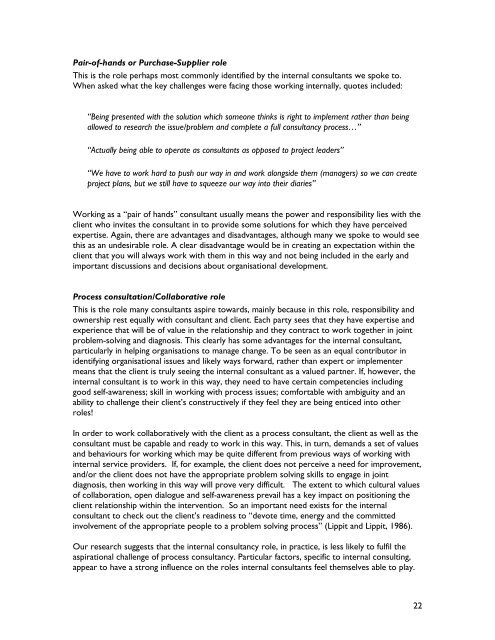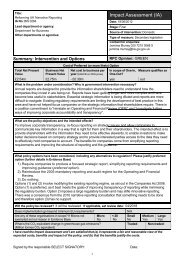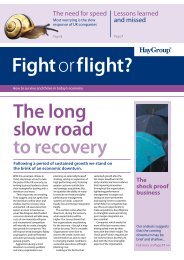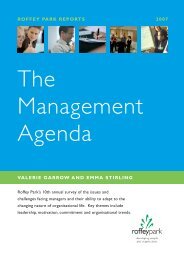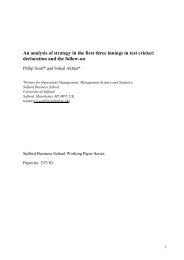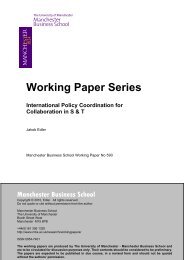The Role of the Internal Consultant - Management & Business ...
The Role of the Internal Consultant - Management & Business ...
The Role of the Internal Consultant - Management & Business ...
- No tags were found...
You also want an ePaper? Increase the reach of your titles
YUMPU automatically turns print PDFs into web optimized ePapers that Google loves.
Pair-<strong>of</strong>-hands or Purchase-Supplier roleThis is <strong>the</strong> role perhaps most commonly identified by <strong>the</strong> internal consultants we spoke to.When asked what <strong>the</strong> key challenges were facing those working internally, quotes included:“Being presented with <strong>the</strong> solution which someone thinks is right to implement ra<strong>the</strong>r than beingallowed to research <strong>the</strong> issue/problem and complete a full consultancy process…”“Actually being able to operate as consultants as opposed to project leaders”“We have to work hard to push our way in and work alongside <strong>the</strong>m (managers) so we can createproject plans, but we still have to squeeze our way into <strong>the</strong>ir diaries”Working as a “pair <strong>of</strong> hands” consultant usually means <strong>the</strong> power and responsibility lies with <strong>the</strong>client who invites <strong>the</strong> consultant in to provide some solutions for which <strong>the</strong>y have perceivedexpertise. Again, <strong>the</strong>re are advantages and disadvantages, although many we spoke to would seethis as an undesirable role. A clear disadvantage would be in creating an expectation within <strong>the</strong>client that you will always work with <strong>the</strong>m in this way and not being included in <strong>the</strong> early andimportant discussions and decisions about organisational development.Process consultation/Collaborative roleThis is <strong>the</strong> role many consultants aspire towards, mainly because in this role, responsibility andownership rest equally with consultant and client. Each party sees that <strong>the</strong>y have expertise andexperience that will be <strong>of</strong> value in <strong>the</strong> relationship and <strong>the</strong>y contract to work toge<strong>the</strong>r in jointproblem-solving and diagnosis. This clearly has some advantages for <strong>the</strong> internal consultant,particularly in helping organisations to manage change. To be seen as an equal contributor inidentifying organisational issues and likely ways forward, ra<strong>the</strong>r than expert or implementermeans that <strong>the</strong> client is truly seeing <strong>the</strong> internal consultant as a valued partner. If, however, <strong>the</strong>internal consultant is to work in this way, <strong>the</strong>y need to have certain competencies includinggood self-awareness; skill in working with process issues; comfortable with ambiguity and anability to challenge <strong>the</strong>ir client’s constructively if <strong>the</strong>y feel <strong>the</strong>y are being enticed into o<strong>the</strong>rroles!In order to work collaboratively with <strong>the</strong> client as a process consultant, <strong>the</strong> client as well as <strong>the</strong>consultant must be capable and ready to work in this way. This, in turn, demands a set <strong>of</strong> valuesand behaviours for working which may be quite different from previous ways <strong>of</strong> working withinternal service providers. If, for example, <strong>the</strong> client does not perceive a need for improvement,and/or <strong>the</strong> client does not have <strong>the</strong> appropriate problem solving skills to engage in jointdiagnosis, <strong>the</strong>n working in this way will prove very difficult. <strong>The</strong> extent to which cultural values<strong>of</strong> collaboration, open dialogue and self-awareness prevail has a key impact on positioning <strong>the</strong>client relationship within <strong>the</strong> intervention. So an important need exists for <strong>the</strong> internalconsultant to check out <strong>the</strong> client’s readiness to “devote time, energy and <strong>the</strong> committedinvolvement <strong>of</strong> <strong>the</strong> appropriate people to a problem solving process” (Lippit and Lippit, 1986).Our research suggests that <strong>the</strong> internal consultancy role, in practice, is less likely to fulfil <strong>the</strong>aspirational challenge <strong>of</strong> process consultancy. Particular factors, specific to internal consulting,appear to have a strong influence on <strong>the</strong> roles internal consultants feel <strong>the</strong>mselves able to play.22


